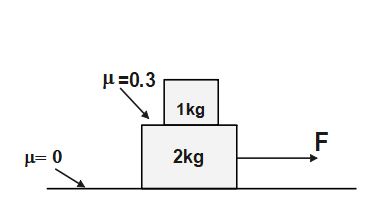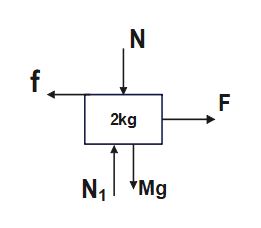How Static Friction helps two blocks to move together !
Q.For given system of two blocks, find the maximum value of force F which can be applied on the system as shown in figure so that both blocks move together. [Given coefficient of static friction between both blocks = 0.3]
(A) 3N
(B) 6N
(C) 9N
(D) 12N

Solution
Free body diagram of block of upper block is
![For given system of two blocks, find the maximum value of force F which can be applied on the system as shown in figure so that both blocks move together. [Given coefficient of static friction between both blocks = 0.3]](https://pcmtutorials.in/wp-content/uploads/2024/02/block-fricition-2.jpg)
We can see that the block 1 Kg (upper block) is moved by friction force. If block moves together (without slipping) it means the frictional force is static friction. Therefore,
f_{s,max}=\;\mu_sN
f_{s,max}=\;\mu_s mg
f_{s,max}=\;\ 0.3 * 1 * 10 = 3N
Thus, maximum acceleration that can be produced in upper block without slipping is
a_{max}=\frac{f_{s,max}}m=\;\frac31=3ms^{-2}
For system of blocks , to move together the maxmium force can be
F_{max}=\;M_{sys,net\;}\ast\;\;a_{max}
F_{max}=(1+2) * 3= 9N
(C) is correct option
In the above example, we can notice clearly that lower block is acted upon by applied (in forward direction) force which causes the motion in lower block [see free body diagram given below].But, the question arises how the upper block is moving in forward direction despite being no direct force on it? What force is there that moves the upper block? The obvious answer is, the friction, which drives the upper block in same direction. Many students might think that how friction can cause motion, as they feel the friction only opposes the motion. Infact , it is a only a misconception that many student grasp due to incomplete knowledge of concept of friction.
Friction necessarily opposes relative motion (sliding) between two contact surfaces, and also some times supports the motion of one object (w.r.t. other frame) while opposing relative motion of one surface over other. When there is no actual relative motion (sliding) between two contact surfaces but exists only the tendency of sliding one surface over the other, then, the frictional force acting between the contact surfaces is static friction. The static friction, as the name says, acts to keep the surface in contact (stationary w.r.t. each other) by stopping the sliding motion between them. To move both blocks together as in the above example, static friction provides the acceleration to upper block while opposing the lower block at the same time so that there is no sliding between them. The acceleration will be maximum when maximum static friction (limiting friction) comes into play. The limiting friction can be calculated by the formula
f_{s,max}=\;\mu_sN
Using the maximum value of acceleration, the maximum force value can be easily found out. We have,
F_{max}=\;M_{sys,net\;}\ast\;\;a_{max}
F.B.D. of lower block

F.B.D. of upper block
![For given system of two blocks, find the maximum value of force F which can be applied on the system as shown in figure so that both blocks move together. [Given coefficient of static friction between both blocks = 0.3]](https://pcmtutorials.in/wp-content/uploads/2024/02/block-fricition-2.jpg)
Conclusion-
Friction plays an essential role in motion despite being a dissipative force. It generally dissipates energy; however, sometimes it utilizes a portion of it to provide kinetic energy to other systems or its own subsystems. In the present case, friction provides kinetic energy to the upper block and performs positive work. Of course, the overall work done by friction is negative. A free-body diagram is necessary for a clear understanding of all forces.
The direction of friction is simply determined by Newton’s third law of motion. It is generally taken in the opposite direction to the applied force on one body (the lower block in this case), i.e., in the backward direction. The direction of friction acting on the other body (the upper block in this case), according to Newton’s third law, will be in the forward direction, just opposite to that of the lower block.
Friction is a contact force. Static friction comes into action until the applied force becomes sufficient to initiate sliding between the contact surfaces. There are also limiting values for static friction because, up to a certain maximum, it tends to prevent actual relative motion, and eventually, sliding begins beyond the limiting friction. Thus, static friction disappears, and kinetic friction comes into play.
